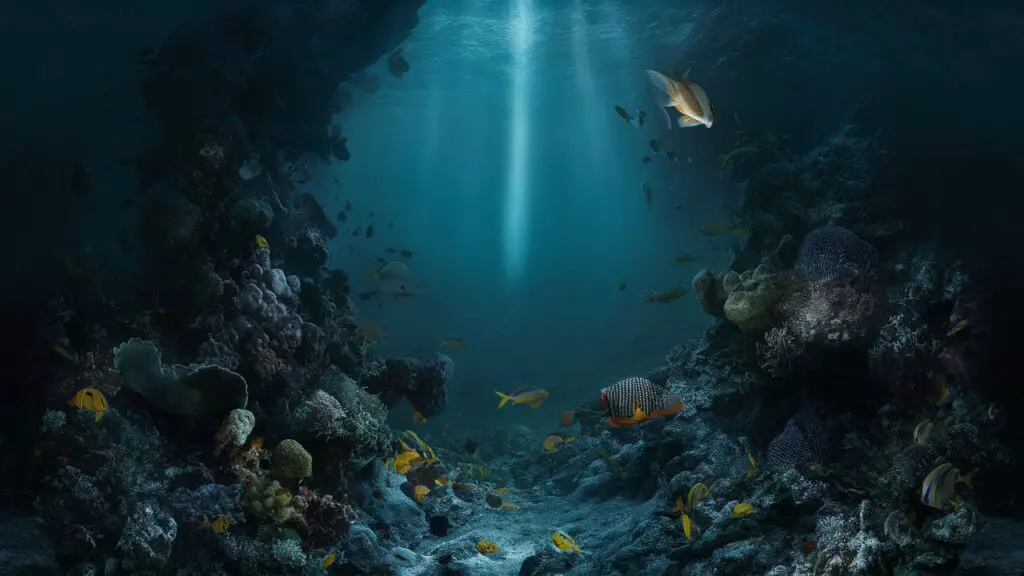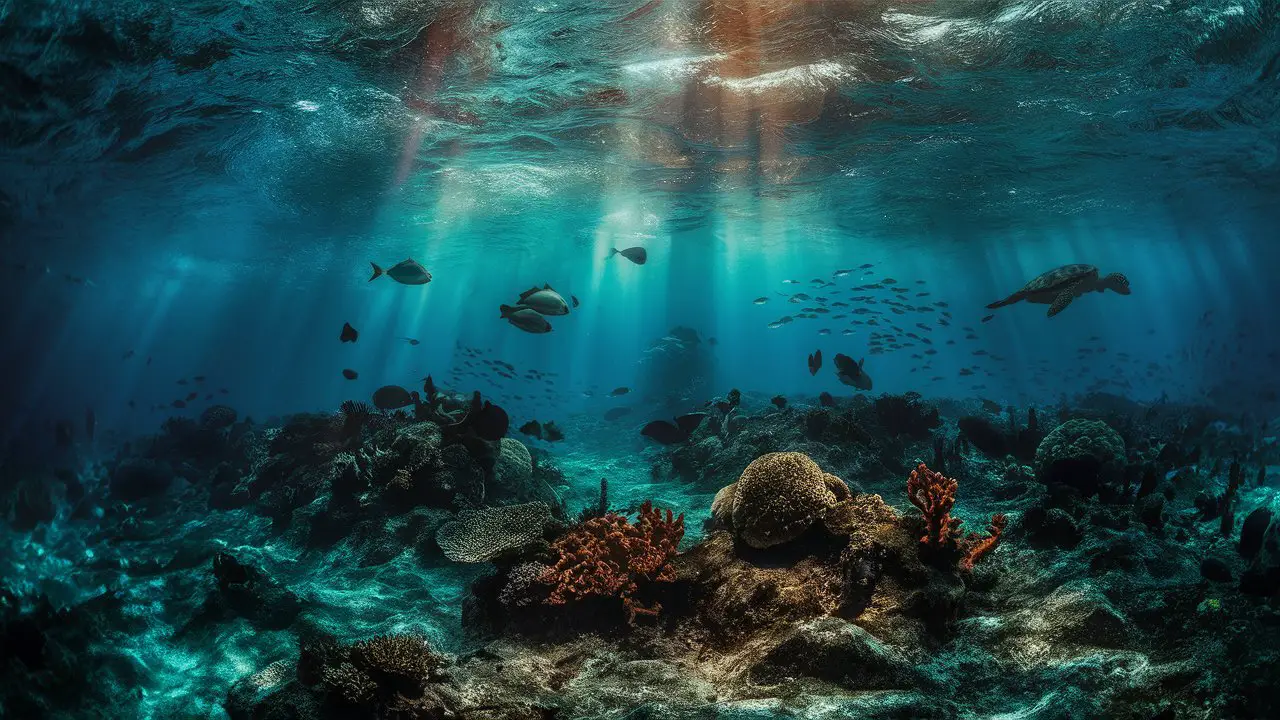As you gaze into the dark abyss of the ocean depths, you wonder what mysterious creatures lurk in that alien world. Though the deep sea covers over half the planet, it remains largely unexplored and hides numerous secrets beneath its waves. Prepare to be astounded as you learn about the fantastical animals adapted to the extreme conditions of the deep. From vampire squid to gulper eels, the eldritch denizens of the deep will challenge your notions of what is possible in life on Earth. Let your imagination run wild as you explore the marvels and mysteries of the deep sea and its bizarre inhabitants. This guide will open your eyes to the strange reality that exists in one of the last truly uncharted frontiers on our planet.
Exploring the Depths: An Introduction to the Deep Sea
The deep sea refers to the lowest level of the ocean, starting around 200 meters below the surface. At such extreme depths, the environment is characterized by total darkness, extreme pressure, low temperature, and scarce nutrients. Yet the deep sea is home to a diverse array of marine animals that have adapted to survive in this harsh environment.
Unique Adaptations
To cope with the immense pressures of the deep sea, many creatures have soft, gelatinous bodies with little skeletal structure. Species like the blobfish and fangtooth fish have squishy bodies and loose skin that is less affected by pressure changes. Others like the tripod fish have large eyes adapted to detect the faintest traces of light. Some creatures like the anglerfish have bioluminescent lures that produce their own light to attract prey in the lightless depths.
Ecosystem Dynamics
The deep sea relies on a process known as biological pump where organic matter from shallower waters sinks down and decomposes. This provides nutrients to support deep sea life. Creatures like tube worms, shrimp, and octopuses feed on decomposing matter, while predators like the viperfish feed on the scavengers. The deep sea floor is also home to massive coral reefs and hydrothermal vent ecosystems fueled by volcanic activity rather than sunlight. These unique ecosystems contain many endemic species found nowhere else on Earth.
Exploration of the deep sea is still largely limited to remote vehicles, but new species are frequently being discovered. The extreme conditions of the deep sea have led to some of the most bizarre and fascinating creatures on the planet. Continued exploration of the deep ocean depths will yield many more discoveries of strange creatures adapted to the most inhospitable places on Earth.
Bioluminescence: Light in the Darkness of the Deep Ocean Creatures
Deep sea creatures have evolved a fascinating ability to produce their own light, known as bioluminescence. This adaptation allows these creatures to navigate, hunt, evade predators, and communicate in a permanently dark environment.
How Bioluminescence Works
Certain organisms contain light-emitting molecules called luciferins that produce light through chemical reactions. When luciferins combine with oxygen, the energy released is converted into light. Special light-emitting organs, known as photophores, contain luciferins and the enzymes to catalyze the light-emitting reaction. Photophores are found on various parts of the organism, including antennae, tentacles, and the underside of their bodies.
Hunting and Defense
Some predatory deep sea creatures use bioluminescence to attract prey in an environment devoid of sunlight. Their light-emitting lures and appendages resemble the glow of potential mates or food sources to lure in unsuspecting victims. Conversely, certain species use counterillumination, matching the faint light from the water’s surface, to camouflage their silhouette and avoid predators swimming below them.
Navigation and Communication
Bioluminescence also serves important navigational and social functions. Some species emit light in rhythmic flashes or pulses to maintain group cohesion or identify members of the same species. The diverse array of bioluminescent patterns and colors seen in the deep ocean point to a complex system of communication that scientists are only just beginning to understand.
The mysterious glow of bioluminescence in the deep ocean highlights the wonders of evolution and adaptation. By producing their own light, these fascinating creatures have unlocked the secrets of survival in an environment perpetually cloaked in darkness.
Extreme Adaptations: How Deep Sea Animals Survive the Intense Pressure
As you descend into the deep ocean, the water pressure increases dramatically. For every 33 feet you go down, the pressure increases by 14.5 pounds per square inch. At the deepest known part of the ocean, the Mariana Trench, the pressure is an intense 8 tons per square inch. These extreme pressures would crush most animals accustomed to surface or shallow waters. However, deep sea creatures have evolved amazing anatomical and physiological adaptations to survive under these crushing loads.
Structural Adaptations
Many deep sea animals have structures that can withstand high pressure, such as gelatinous tissues and skeletons made of cartilage instead of bone. Their cells and proteins are also adapted to function under high pressure. Additionally, their tissues have high concentrations of unsaturated fatty acids which remain fluid even under intense pressure.
Density Adaptations
Some deep sea animals have very high concentrations of solutes in their tissues and blood, which increases their density and reduces the pressure differential across their tissues. Trimethylamine oxide (TMAO) is one such solute that provides protein stability under high pressure. It acts as a molecular crowbar, preventing the proteins from being crushed together under extreme pressure.
Slow Metabolism
Most deep sea animals have a very slow metabolism, which requires less oxygen and produces less waste. Their cells operate at a slower pace under the cold temperatures and high pressure. Some are also able to survive long periods without food, enabling them to conserve energy in their food-scarce environment.
The extreme conditions in the deep ocean have led to the evolution of truly remarkable and bizarre creatures. Their anatomical, physiological and biochemical adaptations for surviving under intense pressure are a testament to the amazing diversity of life on Earth. By understanding how these animals are adapted to their environment, we gain a better appreciation of the range of adaptations possible in nature.
Weird and Wonderful: 5 Bizarre-Looking Deep Sea Creatures
The Fangtooth Fish
The fangtooth fish inhabits the extreme deep sea and is one of the deepest-dwelling fish known. With its oversized teeth and menacing appearance, the fangtooth fish is a bizarre creature. It has the largest teeth of any fish in proportion to its body size. The fangtooth fish uses its enormous teeth to feed on smaller fish and squid in the depths of the ocean.
The Sea Pig
The sea pig, also known as the Scotoplanes, is a type of sea cucumber that lives on deep ocean bottoms, especially in the abyssal zone. It has a plump, rounded body and multiple legs that propel it along the seafloor. The sea pig feeds on organic detritus that drifts down from above. Its odd shape and method of locomotion give the sea pig a peculiar appearance.
The Giant Spider Crab
The giant spider crab inhabits the waters around Japan and is the largest known crab species. It can grow up to 12 feet from claw to claw. The giant spider crab gets its name from its long, spindly legs that resemble those of a spider. However, unlike spiders, the giant spider crab cannot spin webs. It uses its long legs and claws to feed on molluscs, crustaceans, and small fish along the ocean floor.
The Vampire Squid
The vampire squid inhabits the extreme deep sea and gets its name from its dark red color and cloak-like webbing between its arms. Although it shares features with both squid and octopuses, the vampire squid is in an order of its own, known as Vampyromorphida. The vampire squid uses bioluminescent organs at the tips of its arms to produce light, which may help distract predators or attract prey in the deep, dark waters it inhabits.
With strange appearances matched by equally bizarre characteristics, these deep sea creatures highlight the weird wonders of the ocean depths. Largely unexplored, the deep sea remains an enigma that continues to yield peculiar surprises.

Deep Sea Creatures FAQ: Your Top Questions Answered
What kinds of creatures live in the deep sea?
The deep sea is home to a variety of strange and fascinating animals adapted to the extreme conditions found in the deepest parts of the ocean. Some of the most notable deep sea creatures include:
- Anglerfish: These bioluminescent fish use a glowing lure attached to their head to attract prey in the pitch black depths.
- Giant tube worms: Found near hydrothermal vents, these worms have a symbiotic relationship with bacteria that convert chemicals from the vents into nutrients.
- Fangtooth fish: With menacing teeth and bioluminescent markings, these predatory fish hunt smaller creatures in the midnight zone.
- Dumbo octopuses: Named for their ear-like fins that resemble the Disney elephant Dumbo, these octopuses glide through the water hunting crustaceans and worms.
How do deep sea creatures survive without sunlight?
Most deep sea creatures do not rely on photosynthesis or sunlight for energy. Instead, they have adapted in remarkable ways to survive in complete darkness:
- They are scavengers that feed on dead organic matter, like plankton, algae, and waste that sinks from above. Some creatures have mouths adapted for consuming carrion.
- They form symbiotic relationships with chemosynthetic bacteria that convert chemicals like hydrogen sulfide into nutrients. The bacteria live inside the creatures, like in giant tube worms.
- They are predators that feed on other animals, like fish, crustaceans, and cephalopods. Some have bioluminescence or other adaptations to hunt in the dark.
- Some are able to store nutrients for long periods of time due to the scarcity of food. They have slow metabolisms and some hibernate for up to 5 years between feedings.
How deep can some sea creatures go?
The deep sea refers to depths below 200 meters (650 feet), but some creatures live in the extreme deep ocean at depths of 7 to 11 kilometers (4 to 7 miles). At these immense depths, the pressure is crushing and temperatures are near freezing. Some record holders include:
- The Mariana snailfish was filmed at 8,178 meters (26,858 feet) in the Mariana Trench.
- Giant tube worms have been found at deep-sea hydrothermal vents 7,500 meters (24,600 feet) below the surface.
- The fangtooth fish has been recorded swimming at depths of 5,000 meters (16,400 feet) in the midnight zone.
- Camera surveys have spotted Dumbo octopuses swimming at depths of 5,760 meters (18,898 feet) in the Kermadec Trench.
These creatures have specially adapted bodies, metabolisms, and biochemistries that allow them to thrive deep
Conclusion
As you have now seen, the deep sea contains some of the most bizarre, alien-like creatures on our planet. While we have barely scratched the surface in terms of understanding these elusive beings that dwell in perpetual darkness, what little we do know fills us with fascination and awe. The deep sea acts as a humbling reminder that there is still so much to explore and discover right here on our own planet. As technology develops to allow us to plunge deeper into the abyss, the coming years are sure to yield even more surprises from this last great frontier on Earth. Though the deep sea creatures seem like monsters from another world, they are very much a part of the intricate web of life that binds us all together.
Don’t Miss a Thing! Enhance Your Wildlife Photography with Ultra-X Night Vision Goggles.
GET NOW!






